Written by an author with many personal experiences of working on Great Western Railway‘s Castle Class, this book tells the story of their final years of top-link work from 1960 to 62, followed by their decline and the final withdrawal of the last one in 1965.
Published in November 2022 and written by David Maidment as part of Pen & Sword’s “Locomotive Profiles” series, this hardback book is presented in landscape format, measures around 25.14 cm x 24.13 cm, has 184 pages, and 150 colour & 200 black and white illustrations. It has a published price of £30, but at the time of writing Pen & Sword has it on offer online for £27 and it can be obtained from Amazon for £21.75
This is David Maidment’s second volume about the Great Western’s Castle Class locomotives, and covers their final years in British Railways service from 1960 when many were still in charge of most of the Western Region’s expresses. By the summer of 1963 their regular express work was confined to the London to Worcester route.
The book also has many illustrations from their final years, with Castles working relief, parcels, and freight trains, and deputising for failed or unavailable diesels.
The content is enhanced with the author’s experience working and living alongside the class, with descriptions of his own personal experiences on the footplate, on trains, and on shed.
The author has included a number of performance logs that show how Castles, in the hands of competent crews, could still perform at speeds in the high 80s and low 90s. What stands out is how the author brings out how anyone who was around in the 1960s will remember them, often in far-from pristine condition, but still capable of turning in a lively performance.
With five chapters this book is an excellent overview of the Castles in their final years.
Chapter 1 provides a brief recap of the first 35 years of the class, and leads into Chapter 2, which describes the years 1960 to 1962, which was their last years in top-class service. Chapter 3 is dedicated to the author’s personal recollection of the class between 1960 and 1963, and Chapter 4 documents the castles’ decline in the years 1963 to 1965. Chapter 5 is a short assessment of the author’s personal memories of the Castle Class.
The book concludes with a large colour section containing a nostalgic collection of Castles in the south-west, the London area, South Wales, on shed or in works, on the Gloucester and Worcester routes, on freight and parcels work, working the ‘Great Western’ rail tour of 9th May 1964, and in their last years.
An extensive appendix provides an outline weight diagram, dimensions, and technical details for the class . For each engine, there is a list of their build and withdrawal dates, names, if it had a double chimney and when it was fitted, and total mileage.
The Index deserves mention as it also includes a numerical list detailing page numbers for all locomotives and locations illustrated in the book.
The top-left photo below is from the Recap chapter and shows the GWR’s sole attempt at streamlining, with 5005 Manorbier Castle and its bullet-shaped nose on Swindon Shed. The early Castles were rebuilt from Star Class 4-6-0s, and the bottom-left photo shows the first Star that was chosen for conversion, 4064 Reading Abbey. Castles were regular performers on the GWR’s named trains, such as 5091 Cleeve Abbey seen on the Pembroke Coast Express at Cardiff General at the top-right below.
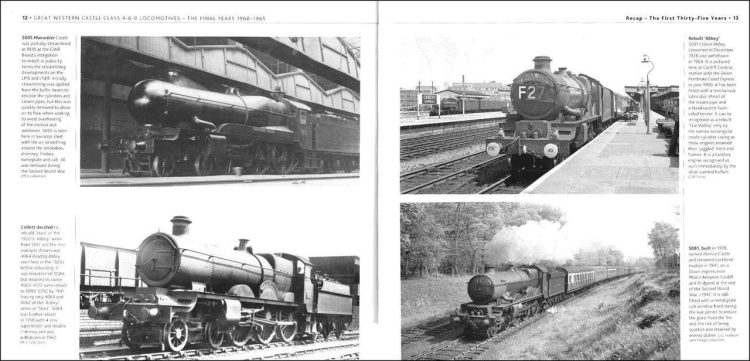
An excellent addition to this book is the inclusion of a number of performance logs such as those shown below that detail comparative times for various members of the class on similar runs.
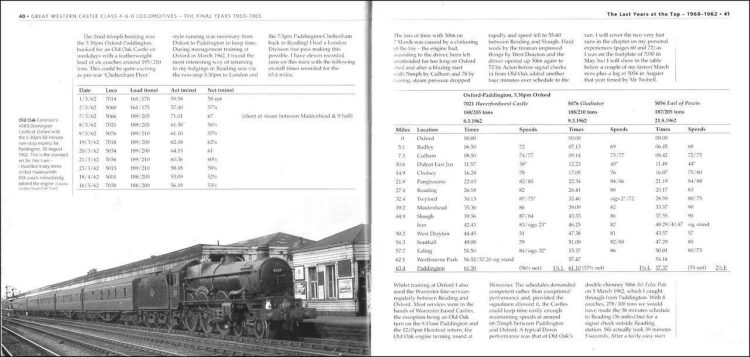
As the end of steam drew near, railway enthusiasts were often presented with depressing sights, such as the examples below. On the left, once-proud members of the class have now been stripped of their name and number plates, whilst an even sorrier sight is the line of castles on the right, although these have not yet been stripped of their identity.
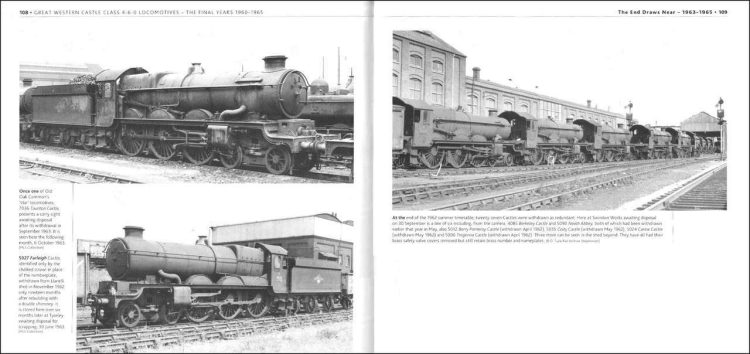
Castles were well-suited to work over the south Devon banks, with many services being double-headed such as in the photo at the top-right below showing a service descending from Dainton summit.
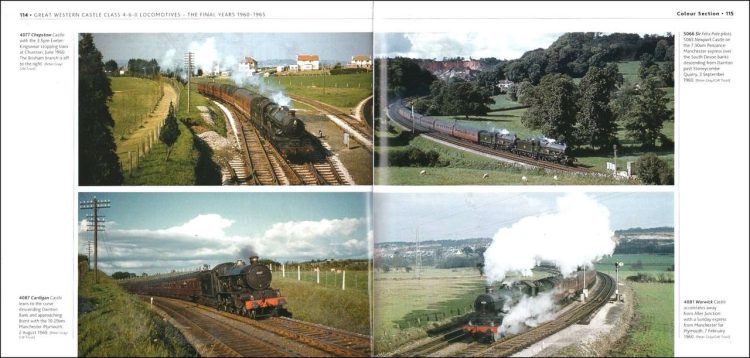
Trains through Dawlish often experienced getting drenched from the high seas as they ran along the sea wall, such as the one at the top left below. Great Western passenger trains often had their headcodes displayed on the locomotive smokebox. The examples below include a ‘generic V’ to indicate a train for the Western Region and an ‘F’ for West Wales. In the absence of suitable headboards, the reporting number would be chalked on the smokebox, such as the one at the top-right below where the’Z’ indicates a special working.
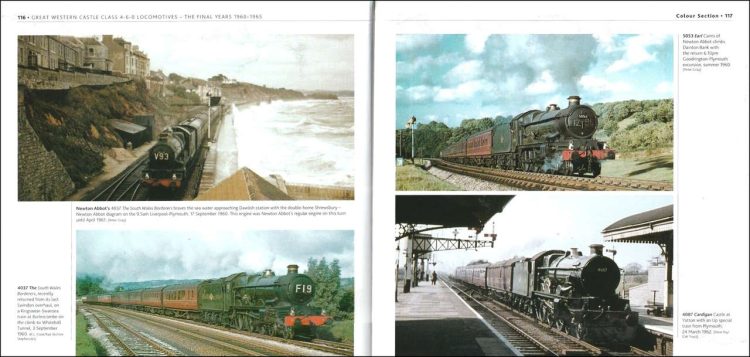
Castles seemed to be perfectly matched to the GWR’s chocolate and cream livery of its carriages, such as the top two examples shown below.
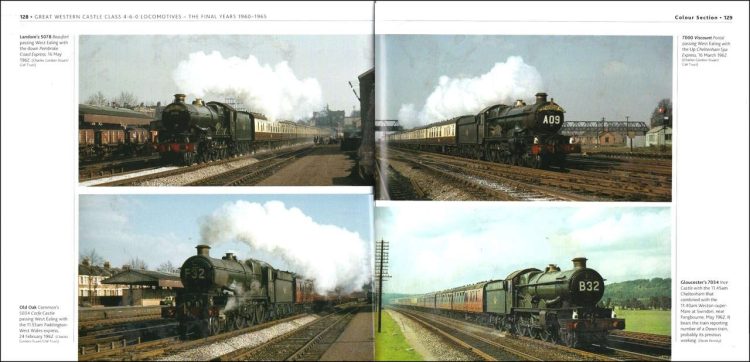
This book continues David Maidment’s impressive collection of books in Pen & Sword‘s Locomotive Portofolios series, which now number over 20 volumes.
This book keeps up the standard of others in the series, being well-produced and featuring well-researched information about the locomotives, diagrammatic drawings, details of where the locomotives were based and operated during their final years, and a well-chosen selection of photographs.
The Personal Recollections chapter is particularly interesting, as it gives first-hand insights into Castles’ performance on a variety of routes. A very-readable mix of timing logs and facts including locomotive details and train weight shows how performance could vary on the same run.
A log of the Pembroke Coast Express on 28th October 1961 behind 4081 Warwick Castle shows most of the 50 miles between Newport and Wootton Bassett were covered at less than 60 mph, whilst between Swindon and Reading speed was consistently in the high 60s and 70s.
Another interesting table is taken from the author’s notebook where he lists the trains he worked on from March 1960 to August 1961 with their punctuality details, which generally shows time being lost.
Overall, the author has compiled the book from his personal records of over 4,500 journeys behind castles, with nearly 800 of them of over 50 miles. These contribute to a well-produced and authoritative book that provides a detailed appreciation of the Great Western Region’s mainstay of its express trains during steam’s swansong.
An essential addition to the bookshelf of Great Western enthusiasts, and interesting reading to the wider railway readership. Highly recommended.
The book is available to purchase from Amazon and from Pen & Sword.
We would like to thank Pen & Sword for providing RailAdvent with a copy of the book for review.






Responses